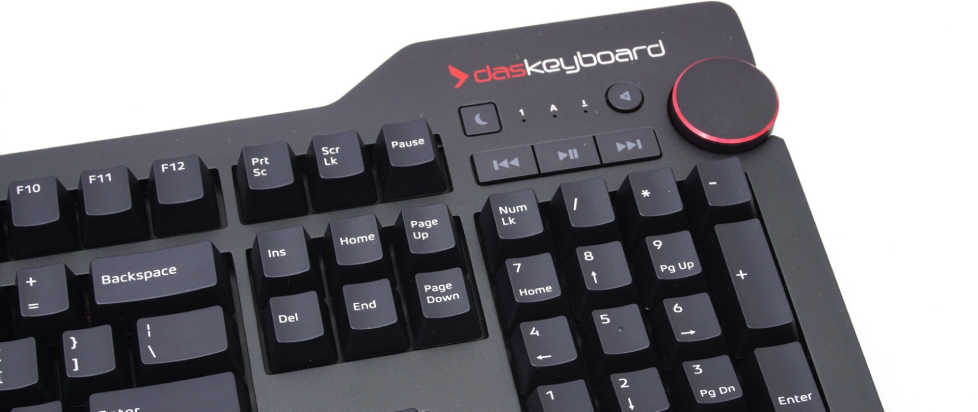
How Daniel Guermeur Changed Touch Typing Forever
“Git gud” has become something of a persistent, if sometimes eye-roll worthy, parlance of the internet. Many of us desire to “level up” our skills, so to speak, but few can say that in the act of doing so, they accidentally founded an entire company in the process. Next to no one could additionally brag about being a runaway success from day one, pushing the forefront of a piece of technology so many take for granted.
However, Daniel Guermeur, the humble, mirthful computer engineer turned DasKeyboard mastermind, is one who could, but he’s too busy innovating how we work. Truth be told, I’m even writing this feature with the review unit they sent me earlier this year, and as I type, I can’t help but marvel at how many fortunate coincidences lined up to bring us to this point.
Born in France, Guermeur grew up in the years where his native country was thoroughly embracing computing. Before we’d come to know the Internet as it is today, France had its own service with the Minitel computer line. “Since I was very young, my passion was electronics and computers. I guess I’m just programmed like that,” Guermeur recalls with a laugh. “As soon as I could start learning and buy a computer, I just really dove into it. Since I was fifteen, whenever I had freetime during the weekends, that’s what I’d do – electronics and software.”
Yet it’s also due to how French computer enthusiasts of their day tended to type that’d lead to a culture shock. “In France? People don’t learn touch typing,” Guermeur explains. Instead, the typical method of the day was two fingers and visually searching across the keyboard. “So nobody really typed fast. But I ended up studying at Stanford University in America, where people type very, very fast. So I came there and I realized – while I was as fast as they were at solving problems, when it came to typing up a program on keyboard, I was the slowest. I was blown away by the speed.”

At first, Guermeur attempted to match his peer’s pace the old fashioned way: brute forcing himself to try and touch-type. To “git gud” like so many others had. These efforts didn’t take, much to Guermeur’s vexation. Yet when on a return trip to the United States for work, something finally clicked. It wasn’t simply a matter of training muscle memory, but relearning how to think about typing. “I was looking at the keys all the time, and if you’re looking at the keys, you naturally hunt and peck,” he says, adding, “That was the ‘Aha!’ moment. I thought, ‘If I can’t look at the keys, I’ll stop looking.’ So what I needed was a keyboard with nothing on it.”
A bare keyboard with no printings of any kind might sound more like a production error, but Guermeur was determined. After failing to find one available for purchase, Guermeur asked his assistant to seek out any keyboard company willing to part with an unprinted model. It took some searching, but three months later, Guermeur finally had a big, sturdy, jet black keyboard with no markings of any kind.
“I typed on it, and I doubled my speed within two months. I was finally touch-typing because I finally stopped looking. So I was really happy, but the weird thing that happened – when people came to my office and looked at the keyboard, they’d say ‘Wow, blank keyboard. You must be good!’” to which Guermeur recalls with a smile, “ And I go like: ‘Oh yeah, I’m good!’” Quickly, Guermeur’s pet project drew an ever stronger fascination from colleagues, with several asking where they might be able to buy their own blank keyboard. After a great deal of pondering, Guermeur finally settled on a simple one-page website. If he received fifteen orders, he’d start selling them on the side, given that he already knew an able supplier. Ten orders, he’d consider making it a side gig. And if only five orders came in, he’d just toss aside the notion. Furthermore, to promote his experimental venture, he passed along a few simple PR emails to sites like Gizmodo, hoping to maybe get mentioned.
Nothing could’ve prepared him for being featured in the New York Times the next week. “Boom, a picture of my keyboard! After the New York Times, ended up being everywhere – on TV, in most newspapers and tech blogs,” he recalls. “In 30 days we sold around a quarter of a million keyboards. And the thing is – I didn’t have any keyboards, only mine! My one keyboard. So I told the customers, ‘Look, you know, sorry, we’re sold out, but while we can refund you now… if you wait three months, we’ll be ready to ship!’” An overwhelming “95%” agreed to their orders effectively becoming pre-orders, because “This keyboard is so badass, we’re going to wait.” Just like that, Daniel Guermeur went from an IT worker to founding DasKeyboard.

All the more surprising, was that when pricing the keyboard, raising the price increased demand. Whereas he’d originally planned a $59 USD price point, $89 would prove the winner. It was all the more baffling as some who said $59 was too high were on board with the literally higher price point. While another strange turn of events, it helped Guermeur to envision his keyboards as a high-end yet immensely practical product, a design philosophy he’s stuck to ever since, even as the market was shifting to far more inexpensive outsourced keyboards.
In the coming years, DasKeyboard grew to encapsulate a range of keyboards, including further iterations of the “DasKeyboard Ultimate” unmarked keyboard. Yet where other brands indulge in fancy effects or gimmicks, DasKeyboard has remained focused on the simple goals of efficiency, quality, and utility. As Guermeur briefly recalls, that drive has sent the company down many design rabbit holes, exploring the validity of split-keyboards, and even toying with an integrated Android unit as a multi-use mousepad in the vein of digital drawing tablets. Yet with every experiment, they tended to find smaller changes mattered the most.
“For example,” he cites, “we were one of the first keyboard manufacturers to add a big round knob to adjust the volume on your keyboard, instead of buttons. Because at the time, Skype was the big thing when you wanted to video conference with anyone, and you’d need to quickly adjust the volume. Otherwise you’d have to reach out for the mouse, fight with the UI – it took too much time. So that was a need: to easily raise and lower the volume.” Being more eco-friendly with later iterations also became a priority, minimizing each keyboard’s energy consumption, including adding a sleep function just for the board itself. More recently though, a subtle yet drastic rethinking of RGB lighting has taken center stage.

Instead of simple vanity, the integration of smart RGB lights that can be paired with various macros, altering the colors to track stock prices or if your PC hardware is being pushed too hard. In a way, it’s something of a full-circle evolution for Guermeur’s designs, harnessing that latent, ambient visual input we get from a nearby window, applied to a keyboard. “We get so many notifications – stocks going up, stocks going down, your email inbox, remembering your mom’s birthday – we have so many notifications and we try to find a way to make that go away.” Where once Guermeur sought to wipe keyboards clean, now he aims to make every key a gentle whisper, reminding you of what matters most. Or, if one prefers, they can do it old school and turn off the lights entirely, virtually replicating the experience of that very first DasKeyboard.
These days, Guermeur works with his team from his home in Texas, always tinkering with ways to better refine the keyboards of tomorrow. Where many might take for granted the clacking keys beneath their fingertips, Daniel Guermeur’s appreciation for the fine art of touch typing has undoubtedly changed keyboards for many. If that isn’t “gitting gud”, I’m not sure what is.
———
With over ten of writing years in the industry, Elijah’s your guy for all things strange, obscure, and spooky in gaming. When not writing articles here or elsewhere, he’s tinkering away at indie games and fiction of his own.


